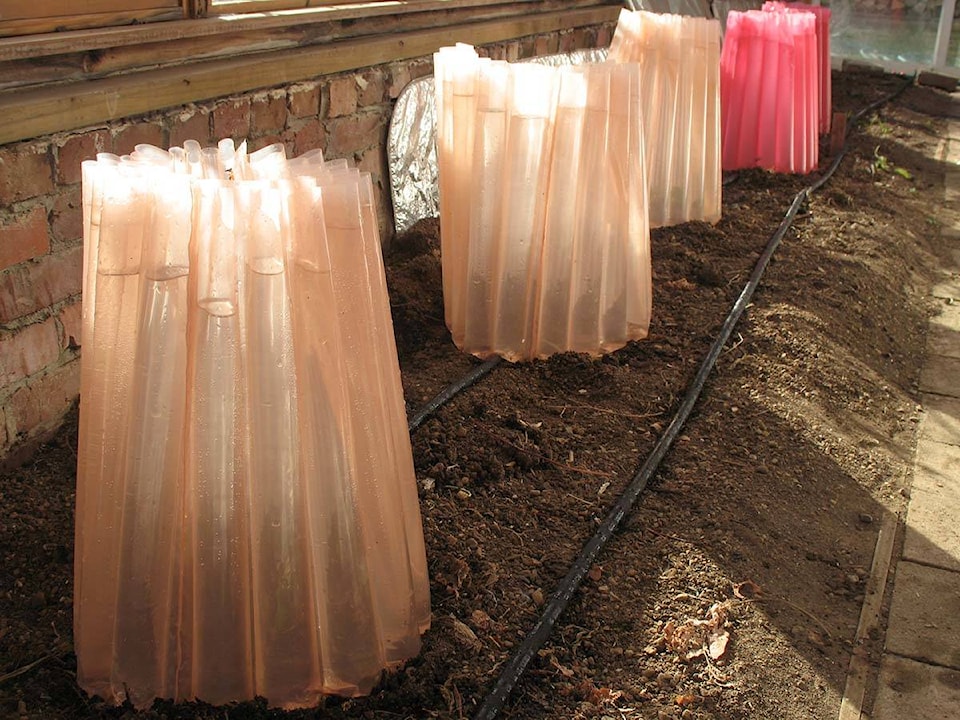By Mary Lowther
Last fall I cut suckers sprouting from branches on my best tomato plants, which I think were Oregon Spring, but since the labels in the ground disappeared, they could be Manitoba or Radiator Charlie’s Mortgage Lifters. I think this year I’ll draw a map of what variety goes where; tomatoes are in the ground for so long that name stakes disappear or the words fade completely. I’d like to blame David but he doesn’t hang out in the garden.
Six of the 12 sprouts I potted up survived and these I’ve transplanted into the unheated greenhouse, each protected by a Wall O’ Waters and we’ll see how they do when compared with tomatoes sown now in the seed table. I kept the clones in a sunny window in the house all winter, watered them when they looked dry with leftover cold tea, vegetable water and plain water and didn’t fertilize them. I recently trimmed and potted up sprouts from these clones too.
I dug six holes one shovelful deep and four feet apart in the greenhouse, poured a quarter cup of organic fertilizer and one cup of compost into each hole and filled them with water. Then I filled up six Wall O’ Waters and put them aside in the greenhouse to warm up for a couple of days. When I first used these Wall O’ Waters, I filled them up in place around the plants and the cold of the water stunted them terribly, so now I warm the protective caps up before placing them over the plants. It’s a hassle picking them up full of water to put over each plant and not squish the plant doing it, but these Wall O’ Waters give me quite a jump on the season so are worth it.
I removed all the lower leaves and flowers to reduce the amount of work for the plants so they can expend their energy making more roots. I laid the plants sideways in their holes, covered up the stems with soil where they will develop more roots, left the top few leaves above ground, then laid a soaker hose along the ground. I’ll water for the next month with warmed water from watering cans I’m keeping in the greenhouse. I don’t want to use cold water directly from the tap yet because it would probably stunt growth. When it warms up I’ll water with the soaker hose for half an hour every four days. I lifted the filled and warmed Wall O’ Waters and placed them over each plant and the hose. When leaves protrude out the top of the Wall O’ Waters it’ll be time to remove them. Since I always manage to spill some water on myself, I don’t wear my dancing slippers for this job.
I attached two lengths of twine for each plant to a wire strung across the ceiling and will tie one per plant to the bottom of each stem once the Wall O’ Waters are removed. As the plants grow, I’ll wind them up around the lengths of twine and allow them to grow to the top of the wire, then I’ll nip off the end so energy will go to developing the fruit remaining on lower branches. I’ll allow one sprout per plant to grow and tie this to the second length of twine. I’ll nip off the rest of the sprouts as they appear, allowing for more air circulation and bigger tomatoes.
Author A. G. Puttoch suggests spraying the first truss of flowers lightly with water or a fruiting hormone each day as they appear in order to ensure a good “set”. This is not necessary for future trusses. I’ll try both sprays and compare results.
I’ll make compost tea in a bucket inside the greenhouse and irrigate the soil with it every two weeks, and will sprinkle organic fertilizer on the soil around each plant every three weeks so maybe we’ll be eating tomatoes early this year.
Please contact mary_lowther@yahoo.ca with questions and suggestions since I need all the help I can get.
